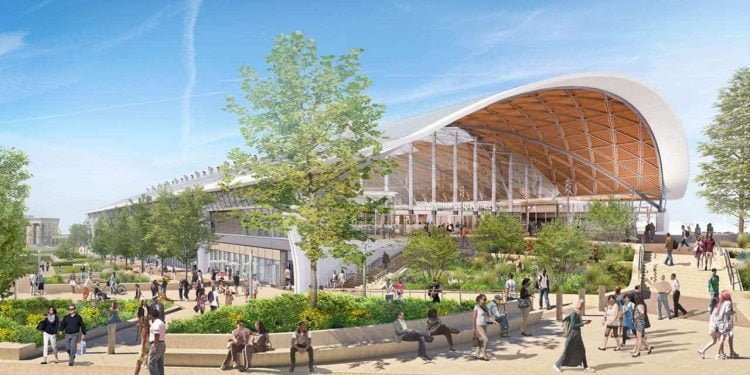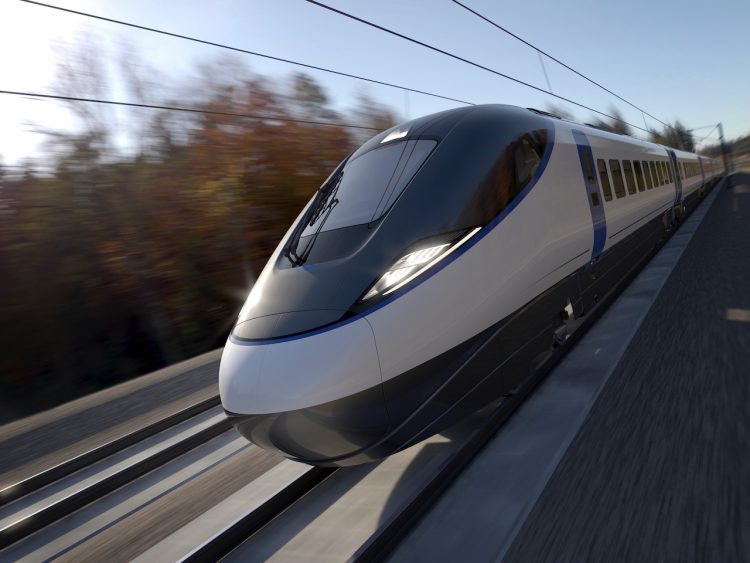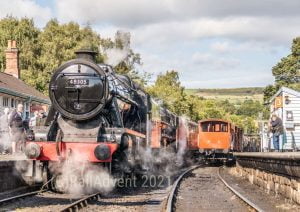HS2 has released a picture showing progress with the construction of the 300-metre-long viaduct that will carry high-speed trains into Birmingham‘s Curzon Street station.
Birmingham Curzon Street will be the northern terminus of HS2, located in Birmingham city centre. It will have seven terminal platforms and is due to open in 2026.

Workers have poured more than two thousand cubic metres of concrete to create the first two ninety-metre deck structures, and are making progress with building two further deck sections. More than eleven thousand cubic metres of concrete will be used in total, with delivery and pouring taking place at night in order to minimise disruption to local roads.
Workers have also built twenty-six piers, each between five and six metres tall, to carry the viaduct. They are building four huge steel tripods to support the viaduct over Digbeth Canal.
Once the concrete has been poured on each section, workers will spend the next few months removing the shuttering and scaffolding, applying the precast parapets and carrying out other finishing works.
They will build further sections of the viaduct in the same way. Then, next summer, workers will complete the span over the canal using jacks to slide thirty-four temporary steel girders, each thirty-eight metres long, below the four steel tripods to support the formwork and further deck construction.

Curzon Viaduct No.3 is one of a series of five connected viaducts between Washwood Heath and Curzon Street Station in central Birmingham. As it approaches the station, the viaduct widens from a single deck to four separate decks, spanning sixty-five metres at the widest point, to carry seven tracks to the platforms. Work will begin on Curzon Street station next year.
HS2’s Midlands contractor Balfour Beatty VINCI is building the viaduct, and is deploying more than 150 workers, including local joiners, steel fixers and scaffolders, including five apprentices. Balfour Beatty VINCI’s Design Joint Venture, made up of Mott MacDonald and SYSTRA (MMSDJV), designed the viaduct. Steelwork specialists Severfield, based in Bolton, manufactured the steel tripods.

David King, Senior Project Manager at HS2 Ltd said: “It’s fantastic to see this iconic viaduct taking shape in central Birmingham. This is one of our busiest construction sites, as we now reach peak construction on key HS2 structures across the Midlands, with over 9,750 people in the region working on the project.”
“The design of the viaduct is part of our vision to maximise social and economic development opportunities around Curzon Street Station. Widening to four separate decks near the station will maximise daylight underneath the viaduct, creating opportunities for a usable and flexible public space.”
Lenka Vosvrdova, Curzon Street Site Agent at Balfour Beatty VINCI said: “We’re extremely proud of the significant progress our team have made on the Curzon Street Viaduct site. Since we revealed the first giant pier in January this year, we have successfully constructed 26 new concrete piers, with the first sections of the four-span viaduct also nearing completion.
“Over the coming months, works will ramp up on the series of viaducts in Birmingham, as we continue to build structures over Digbeth Canal, Lawley Middleway and the original Victorian railway line.”
Nicholas Robertshaw, MMSDJV Design Lead, added: “We’re delighted to see this superstructure starting to take shape and transform the Birmingham skyline.
“The Curzon Viaduct is positioned in a challenging built-up environment, adjacent to a Network Rail corridor. It’s only through the tireless work of the Design Joint Venture that we’ve been able to overcome these constraints. We feel we’ve produced an iconic design which everyone, including residents of Birmingham, can take pride in.”





Responses
A big waste of money in many peoples thoughts just to save a few mins time on london route. This money could be going to some thing useful like homeless or to tackle illegal immigration which is costing us billions a yr in putting them up homing an feeding them.etc. A big waste of tax payers money in my eyes.
I have seen the vast area which will be occupied by this project from the train going out of New Street station. I asked myself then and continue to ask if the huge scale is really necessary. We are not talking about another Eurostar terminal. The Curzon Street station area seems to be twice the size of St Pancras. No wonder that the northern arm had to be cancelled to save money.